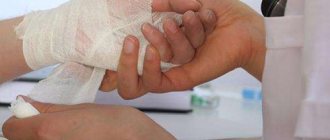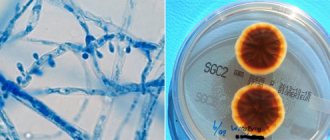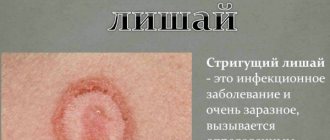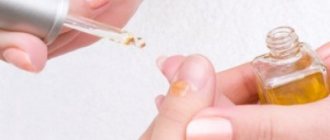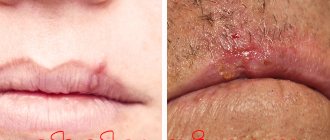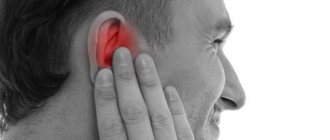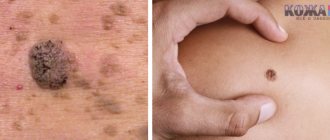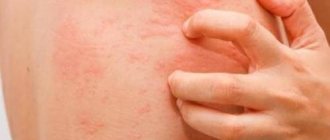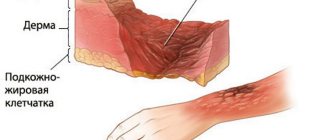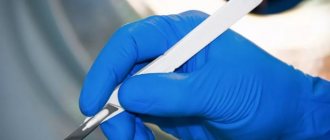With severe internal diseases, poor nutrition, and with age, nail growth slows down and its structure undergoes changes. Only a doctor can accurately determine the cause of the disorder based on the results of tests and microscopic examinations.
But to get an idea of what happens to your toenails or fingernails, you can use photos of different types of fungal diseases.
Causes of nail deformation
Molds, yeast-like fungi and dermatophyte fungi cause infectious diseases of the nails (onychomycosis), which manifest themselves with similar symptoms.
All types of nail fungi on the toes or hands deform the nail plate, change its transparency, shine, color; this variety can be seen in the presented photos.
Nail changes occur not only with onychomycosis, but also with injuries, chronic paronychia (inflammation of the nail fold), psoriasis, hand eczema, and dermatitis. Before making a conclusion about a fungal infection, you need to consider all possible options.
Prevention
Preventive measures help avoid infection and reduce the risk of relapse of the disease. The patient should eat properly, maintain foot hygiene, and not share someone else's shoes or use a shared towel. When visiting saunas or swimming pools, wear personal rubber slippers and wash them thoroughly at home.
Mycosis of the toenails is an unpleasant and dangerous disease. The infection can penetrate deeper layers and affect the nail plate and matrix. Preventing the disease is easier than treating it, but if infected, the patient should seek qualified help as soon as possible. Special creams, varnishes and tablets can stop the growth of mycelium and destroy the cell wall. It is important to understand that the treatment is long-term, so you should expect a therapeutic effect no earlier than after 3 weeks.
Signs of fungal infection
The most informative signs of fungal infection are changes in the color of the nail plate, the presence of nail detachment, surface changes - transverse and longitudinal grooves on the nail plate, pinpoint depressions, thickening, and destruction of the nail.
The pink color of a healthy nail is determined by the transparency of the nail plate and the blood vessels visible through it. With onychomycosis, the nail loses its transparency, the color becomes brownish, yellow, and less often green or black.
Candida fungi and dermatophytes cause onycholysis - separation of the affected part of the nail. When infected with dermatophytes, onycholysis is observed from the distant edge of the nail, and when infected with Candida, the nail lags behind the nail bed at the base, in the crescent area.
A symptom of candidal fungus can be inflammation of the lateral periungual ridges - paronychia. This disease has bacterial forms caused by streptococci and staphylococci, as well as non-infectious forms - eczema, psoriasis, systemic vasculitis.
When the toenails are infected with the fungus Trichophyton rubrum, the plate is affected, as can be seen in the photo, the roller is not affected by the infection. The plate becomes yellowish, becomes very thick, and the accumulated fungal masses are clearly visible under it.
Symptoms
Basically, mycosis develops from the corner of the nail of the first toe, since its free edge is traumatic and more susceptible to infection. The disease develops slowly, and it can be suspected by the following symptoms:
· at the initial stage, the manifestations are minimal - a change in the thickness of the nail plate is visually noticeable - more often it thickens. A little later, bumps, longitudinal or transverse stripes, yellowish or white spots appear;
· with hypertrophic lesions, the thickening of the nail is greater. The natural shine of the nail disappears. Itching and burning occur, the skin around the affected area turns red and peels; the nail plate becomes cloudy, loses transparency, becomes deformed, and later changes color to greenish or brown;
· at the atrophic stage, the nail hurts when you press it, the skin around it swells, the plate becomes gray, is torn away from the nail fold and crumbles, exposing the nail bed.
As the disease develops, the clinical picture changes depending on the type, and characteristic signs appear.
Nail fungus due to infection with dermatophytes
In 95% of all cases of nail fungus, the disease is caused by the dermatophytes Trichophyton rubrum and Trichophyton mentagrophytes.
Trichophyton rubrum infection
Onychomycosis begins when the fungus penetrates under the nail plate from the free edge. A fungal infection is indicated by the appearance of a yellowish spot, an uneven, crumbling surface of the distal (remote) edge of the nail in the area of the spot.
A distal-lateral form is common . In the photo you can see that the stain caused by the introduction of the fungus is located along the lateral periungual fold of the nail.
The fungus Trichophyton rubrum typically affects the big toes, causing hyperkeratosis - a collection of fungi between the nail plate and nail bed that looks like a loose, yellowish mass in photos.
At this stage, the fungus occupies a small part of the nail, as in the photo shown, and with the help of local treatment it is possible to cope with the onychomycosis that begins.
Without treatment, the spot grows, gradually affects the entire edge of the nail, and then moves to the crescent. In the photo, the nail fungus looks like yellowish stripes directed towards the growth area of the nail plate.
With the distal form of nail fungus , often found on the big toes, a yellowish spot of infection appears on the distant edge of the nail, in its central part, as can be seen in the photo.
At an advanced stage of toenail fungus, several nails are affected, as in the photo, and treatment is no longer limited to local remedies and tablets. In addition to antifungal drugs, the nail is subjected to hardware cleaning, and the nail plate is removed completely or partially.
Long-term therapy with the use of all known antifungal agents and treatment methods is necessary for the leg caused by Trichophyton rubrum with hyperkeritosis, as can be seen in the photo.
A fungal infection with a total lesion of the nail spreads to the entire area of the nail plate, the nail is completely destroyed.
Infection with another representative of dermatophytes, the fungus Trichophyton mentagrophytes, can also lead to total fungal infection of the nail.
Trichophyton mentagrophytes infection
With a total infection of the toenail by Trichophyton mentagrophytes fungi, the nail plate becomes deformed; the photo shows that it thickens, changes structure, collapses, and yellowish spots appear over its entire surface.
Infection of the nail with this dermatophyte usually causes superficial white onychomycosis of the big toe and, less commonly, the little toe.
This fungus is practically never found on fingernails; it often causes interdigital dermatophytosis on the toes, as in the photo, and requires simultaneous treatment of the skin of the feet and nails.
A symptom of nail fungus infection, usually on the toes, are white spots of different sizes, as in the photo, reminiscent of leukonychia - a disease of the nail plate itself.
But unlike leukonychia, in which white spots are caused by the appearance of air bubbles in the layers of the nail, white spots with a fungal infection are the result of the activity of Trichophyton mentagrophytes.
Rarely, superficial white onychomycosis is caused by mold fungi; in AIDS, the causative agent of this type of fungus can be Trichophyton rubrum and affect the nails of both the feet and hands.
We recommend reading the following article: How to cure nail fungus.
How to treat diaper rash between the toes?
The appearance of diaper rash can be guessed by the characteristic redness of the skin, itching, plaque, bleeding rashes, and an unpleasant odor. Fungal infections, improperly selected shoes, and insufficient hygiene can provoke the appearance of such symptoms. If diaper rash on the legs is not treated, the disease can become chronic. In addition, a bacterial infection may occur, which will complicate the course of the disease.
Reasons for appearance
Diaper rash between the toes can occur for various reasons. Moreover, the problem itself has several forms (just look at the photos on the Internet). More often, this disease develops against the background of a provoking external influence - rubbing of the skin in non-hygroscopic shoes made of artificial materials, friction of the fingers due to the tightness of the shoes (especially between the little finger and the 4th finger).
Often, diaper rash between the toes appears due to excessive sweating. In this case, the constant warm and humid environment in this place becomes favorable conditions for the growth of the fungus.
The following factors contribute to the development of fungal diseases and the appearance of diaper rash:
- insufficient foot hygiene;
- wearing rubber shoes for a long time;
- obesity (such people sweat more);
- fungus between the toes often appears after visiting saunas, swimming pools, or dubious beauty salons;
- leatherette shoes;
- hyperhidrosis (excessive sweating contributes to constantly increased humidity in the interdigital folds of the feet);
- immunodeficiency states;
- various allergic reactions;
- diseases of the cardiovascular system;
- diabetes;
- if the skin between the fingers is injured, this facilitates the penetration of infection;
- metabolic and endocrine disorders in the body.
Drug treatment
First of all, it is necessary to protect your feet and toes from the mechanical effects of tight, airtight shoes. That is why, with such a foot problem, treatment should begin with choosing high-quality, comfortable shoes.
Pensioners! Don't cut fungal nails! They are derived simply: take 9 grams...
Military doctor: So that the soldiers do not have fungus, they 2 times a day...
If the skin on your feet often becomes dry, you need to take proper care of it every day. Every day in the evening, it is advisable to steam your feet in soda and soap baths. Baking soda and laundry soap have not only a disinfectant, but also a local antiseptic effect. After these procedures, the feet are thoroughly dried and an anti-diaper rash remedy prescribed by the doctor is applied to them. Doctors usually recommend:
- zinc drying ointments;
- various tar pastes;
- talc;
- baby powder;
- special baby creams;
- boric acid solution;
- Teymurov pasta;
- The light of an infrared lamp dries and disinfects the skin.
Important! The maximum effect is achieved when treating diaper rash with anti-inflammatory and wound-healing ointments “Panthenol” and “Levomekol”. You can also use “Rescuer” balm.
If the cause of the illness is a fungus, you should consult a doctor before treating fungus and diaper rash between your toes. Only a specialist will be able to accurately identify the causative agent of the disease and select effective treatment. Antifungal drugs are usually prescribed for topical use. They should treat the interdigital area.
Folk remedies
Treatment of diaper rash between the toes can be carried out using traditional medicine recipes. Below we present some of the simplest folk recipes:
- Baths with the addition of medicinal herbs help well. Oak bark, calendula and pine needles are especially effective. These herbs reduce sweating, quickly heal the skin and have a local bactericidal effect.
- The easiest way is to lubricate the areas between your fingers with brilliant green. It disinfects and dries the skin.
- Traditional medicine also recommends wiping areas with diaper rash with boiled sunflower oil.
- For medicinal and preventive purposes, you can make lotions from a decoction of the herbs sage, chamomile and celandine.
- Treating areas with diaper rash with iodine solution will also be effective. To do this, add three drops of iodine to a glass of boiled water.
- Buckwheat flour can be used to make a natural drying powder.
More effective treatment is carried out with means on a multicomponent basis:
- You can prepare an infusion from the following herbal collection: sage (80 g), horsetail and valerian root (10 g each). Pour the mixture of herbs with boiling water (0.25 l) and let it brew for an hour. Then we filter the infusion and use it as a rub or lotion on the affected areas.
- Baths with an infusion of calendula and pine needles will help to significantly reduce sweating and inflammation. To prepare the infusion, you need to infuse 15 g of each plant in a glass of boiling water.
- A mixture of oak bark and chamomile can be used to prepare medicinal baths or a treatment for areas with diaper rash. To do this, brew 50 g of each medicinal plant in a thermos on the basis that we will need 500 ml of boiling water. After 6 hours, filter the infusion. It can be added to baths or used as an independent wiping product.
- Compresses of crushed flax seeds can be applied to sore areas. To do this, crushed seeds are brewed with boiling water.
- Lotions made from eucalyptus leaves steamed in a water bath in a glass of boiling water are useful. For 250 ml of water you will need 60 g of medicinal plant. Heat in a water bath for 7 minutes.
Yarrow infusion is considered a very effective remedy for diaper rash, cracks and skin lesions. To prepare it you will need 60 g of dry herb and 0.35 liters of boiling water. Place the herb in a thermos and pour boiling water over it. Leave covered for an hour. After filtering, the infusion can be used to wash the affected skin.
Changes in the nail due to infection with Candida fungi
The fungus usually occurs in women and affects the nails on the working hand, which often comes into contact with water.
Candidal onychomycosis is characterized by a proximal form of infection, in which the fungus first affects the nail fold at the base of the nail, then penetrates the growth zone and nail bed. After which it gradually moves along the nail from the base to the edge, capturing an increasingly larger area of the nail plate.
The causative agent of candidal onychomycosis is Candida albicans. This fungus invades the toenails and fingernails, spreading from the crescent area at the base of the nail plate to the free edge, as can be seen in the photo.
A sign of a nail infection with Candida albicans is inflammation of the nail fold (paronychia), separation of the cuticle from the nail plate, pain, and discharge of pus when a bacterial infection is attached.
The fungus Candida albicans can penetrate the nail from its free edge. In this case, we speak of a distal form of infection, which is usually combined with cutaneous candidiasis.
Treatment of candida fungus on the fingernails and toenails when more than half the area of the nail plate is affected, as in the photo, includes not only the fight against onychomycosis, but also measures to reduce the activity of candida in the natural reservoirs of their storage - the intestines, oral cavity, and genital mucosa.
You may be interested in our next article: Remedies for candidiasis onychomycosis - nail fungus on the hands and feet.
Treatment of the initial stage of the fungus
In most cases, to treat the early stage of onychomycosis, drugs that have a local effect directly on the affected nail are sufficient. Tablets and injections are prescribed for more advanced stages.
In advanced cases, medical assistance is required
Folk remedies are used to treat nails at home. It is better to combine them with pharmacological medications for external action.
Folk remedies
There are many folk remedies that will help cure nails affected by fungus at the initial stage. Let's look at effective, yet simple recipes.
Sometimes regular iodine can help quickly get rid of fungus
- Iodine – apply 1 drop of 5% iodine to the affected nails daily until symptoms disappear. The procedure is carried out in the morning and also in the evening. More material about iodine treatment.
- Mix 1 teaspoon of iodine, vinegar, glycerin and dilute with 6 teaspoons of water. Rub your nails with the resulting mixture for 10 days in a row. The composition on the nail plate must be left overnight.
- Vinegar – prepare a bath by diluting 1 part 9% vinegar with 8 parts warm water. Soar your feet or hands in it for 20 minutes. Carry out 7 procedures every other day. More material about vinegar treatment.
- Egg ointment - put a raw chicken egg in the shell into a glass and fill it to the top with 9% vinegar. When the shell dissolves, remove the remaining film and mix the egg with vinegar. Apply the resulting mixture twice a day to the affected areas for 2-3 weeks.
Chicken egg ointment is also quite effective against nail mycosis
- Hydrogen peroxide – dilute 2 tablespoons of hydrogen peroxide 3% in 2 liters of water. Steam your arms or legs, depending on where the fungus is located, for 20 minutes. Repeat the procedure for 7-10 days in a row.
- Peroxide compress - soak a cotton swab with peroxide and apply it to the nails that show signs of fungus. Before this, your hands or feet need to be steamed in a soda bath. To prepare it, 1 teaspoon of soda is diluted in 1 liter of water. The top of the compress is wrapped in cellophane or cling film and left for 60 minutes. This is necessary so that the peroxide does not evaporate. Repeat the procedure for 10-14 days, twice a day.
- Propolis tincture - dip a cotton swab in alcohol tincture of propolis 20% and apply to the affected areas. Keep the lotion until the composition dries. Repeat daily until recovery. 1-2 procedures per day are enough.
- Washing powder is a method suitable for treating toenails. You need to dissolve 100 g of washing powder, which contains a lot of alkali, in 2 liters of water. Keep your feet in this bath for 15 minutes. Repeat 10-14 procedures until symptoms disappear.
- Garlic – cut a peeled clove of garlic, dip in salt, and then rub on the nail plate. Repeat twice daily until symptoms disappear.
- Ammonia – dilute 1 tablespoon of ammonia in 1 glass of water. Cotton fabric is impregnated with the resulting solution. You need to wrap your legs or arms with it and leave this compress overnight. Repeat the procedure for 7 days every day.
- Onion – chop the onion to a paste consistency and apply to the affected nails for 30 minutes. Repeat twice a day until recovery.
Chopped onions will help restore your nails to a healthy look.
- Mix chamomile, sage, mint, you can take dry or fresh herbs. Place the resulting mixture in a sock or glove overnight. Herbs need to be changed every evening. Repeat the procedure in combination with other recipes until the symptoms of the fungus disappear.
- Boric acid - cotton swabs soaked in boric acid are applied to pre-steamed nails. You need to keep the lotion for 30 minutes. The procedure is repeated for 10 consecutive days every day.
- Celandine and tea tree oils - mix these products in equal proportions, soak a gauze bandage with the resulting mixture and apply it to the nails for 20 days in a row for 45 minutes. The recipe is contraindicated for pregnant women.
- Soda – dilute baking soda with a small amount of water to a paste consistency. Apply it to your nails for 20 minutes, and then rinse with warm water for 10-12 days, twice a day.
- Apple cider vinegar - dilute it with olive oil. The required proportion is 2 parts vinegar to 1 part oil. Apply the mixture to the affected nail plates until the nail grows completely.
- Tea tree oil – apply a couple of drops of oil to your nails until the fungus-affected areas of the nail plate grow completely.
- Willow – chop 500 g of young willow shoots, add 2 liters of water, bring to a boil. Make hand or foot baths three times a week from the prepared decoction for 20 minutes until recovery.
- Nettle – brew 3 tablespoons of nettle leaves in 400 ml of water. Soak cotton swabs with this decoction and apply them to the nail plates twice a day until recovery.
- Grind the rowan leaves and apply a thick layer on the nails, and then wrap with cling film for 30 minutes. Repeat the procedure daily for 12-14 days.
Before using folk remedies, it is necessary to check whether there is an individual intolerance to the components of the recipes.
If treatment with folk remedies does not give the desired result, consult a doctor
More material on softening nails in older people, for cutting and for fungus, can be found in this article.
Medicines
After it has been possible to recognize the type of fungus that has affected the nail, the doctor selects medications that will help destroy it. It is most convenient to treat the initial stage of onychomycosis with local agents: varnishes, ointments and creams. Let's look at the most effective drugs.
Read: Treatment of cracked fingernails
Varnishes for mycosis
They are effective precisely at stage 1 of mycosis, when no more than 50% of the surface of the nail plate is affected. This product is convenient to apply and adheres well to the nail, thanks to which the active substances penetrate deep into the affected nail and do not wear off.
→ Large overview of antifungal varnishes
The most popular varnishes:
- Batrafen - its active ingredient Ciclopirox is active against 58 varieties of fungi. Varnish is applied every other day. If the symptoms do not go away within 1 month, the number of uses is reduced to 2 times a week. During the 3rd and subsequent months of therapy, the varnish is applied once a week. Side effects from this remedy include urticaria and itching. It is contraindicated for pregnant and nursing mothers, as well as children under 10 years of age. Cost – from 2,200 rubles.
- Loceryl - the active component Amorolfine destroys many fungi. Apply to the affected areas of the nail twice a week until they grow. Not prescribed for children, pregnant women, or nursing mothers. The use of this product may increase nail fragility. Price – from 1,300 rubles.
- Mikozan - created on the basis of natural ingredients. Treatment lasts 4 weeks, during which the varnish is applied 2 times a day. Suitable for prevention. Side effects are itchy skin. The product is contraindicated for pregnant women. Price – from 870 rub.
Mikozan varnish is one of the most effective remedies against nail fungus
Other antifungal varnishes are Oflomil, Cyclopiroxolamine, Demicten, Lorecil, Flamin.
Antifungal ointments and creams
Contains an optimal concentration of active ingredients to fight fungus.
→ Review of antifungal ointments
List of effective drugs:
- Exoderil - cream with Naftifin. Apply 2 times a day until the affected nail grows, and then continue use for another 2 weeks to consolidate the result. Side effects - itching is possible, which goes away quickly. Contraindications: pregnancy, age under 12 years. Cost – from 480 rub.
- Mycozoral is an ointment containing Ketoconazole, which quickly stops the growth of fungi. You need to apply it to the affected nails until they grow back twice a day. Side effects - allergies. Contraindications for use – the presence of cracks or damage on the nails. Price – from 250 rub.
- Clotrimazole – contains Clotrimazole, which kills all types of fungi. The duration of treatment is a month. The cream is applied daily three times a day. No side effects were identified. Contraindications: pregnancy. Cost – from 70 rub.
Clotrimazole - cream for external use 1%
Other effective topical agents are Zalain, Nizoral, Nitrofungin, Mifungar, Fundizol, Lamisil.
Read: Doctor Myasnikov about nail fungus
Before each application of varnishes, as well as ointments and creams, the nail must be prepared. To do this, it is steamed, after which it is cut off as much as possible. You should try to remove the affected areas with a nail file. An individual tool must be used for each nail.
In rare cases, when the disease progresses very quickly, the doctor may prescribe pills. Fluconazole, Itraconazole, Ketoconazole, Terbinafine have an antimycotic effect.
Damage by mold fungi
Molds cause fungi much less frequently than Candida or dermatophytes. The main symptom of toenail infection with mold is, as can be seen in the photo, a change in the color of the nail plate to blue, black, or greenish.
Signs of mold fungus on the toenails can be dark spots, dots on the nail plate, or, as in the photo, a black longitudinal stripe.
We recommend that you read the article Mold and candidal onychomycosis.
Antifungal drugs
To treat nail fungus caused by dermatophytes, such as in this photo, use antifungal agents with fluconazole, ketoconazole, terbinafine, itraconazole, griseofulvin.
When infected with dermatophytes, antifungal agents with terbinafine are effective - Lamisil, Exifin, Terbizil, Tsidokan, Binafin, Exiter, Fungoterbin, Terbinafine-Teva.
Antifungal agents with voriconazole (Vfend, Biflurin, Vikand, Voriconazole Canon) show high activity against dermatophytes.
Voriconazole is also used to treat molds of the toenails , hand nails, and against the yeast-like fungi Candida . The spectrum of action of voriconazole includes molds such as Aspergillum, Fusarium, Penicillium.
Medicines based on itraconazole - Orungal, Itrazol, Itraconazole-ratiopharm, Irunin, Rumikoz, Kandtral - cope with mold fungi.
Fluconazole, itraconazole, and ketoconazole are used to treat nail fungus caused by Candida albicans. The most well-known products with fluconazole are Diflucan, Mikosist, Flucosan.
Our article Antifungal drugs for the treatment of skin and nail fungus will help you learn more about anti-fungal drugs.
